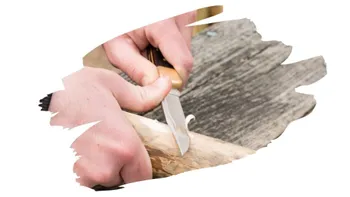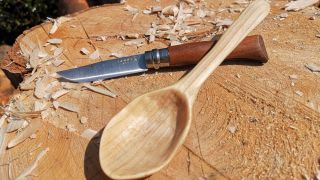
It can be intimidating to start carving spoons by hand. There are many methods that make it easy. Here are some tips for spoon carvers. Learn about the best woods, how to care for them, and what tools you should use. You can create stunning spoons in no more than a few steps. This will ensure that you have many years of useful use in your kitchen.
Lessons learned
There are many things to remember when carving cedarspoons. The most important thing about carving cedar spoons is the wood type. There are many wood types that can be carved. However, some types of wood are more easy than others. Cherry and other soft hardwoods are best for beginners. You can always test it out on a smaller piece to get an idea of how it looks.
Once you have the basic shape of the handle in mind, you can move on to the head. It's easier to carve spoons with the convex sides, so you might choose to start there. You will need to remove the material around the edges of the spoon to create a smooth slope. With a rounded sweep saw, smoothen the spoon's face.
Woods for work
Two types of wood are available for spoon carving: Eastern Red Cedar (or Yellow Cedar). These woods are much easier to carve than Western Red Cedar. Both woods have their pros and cons. However, they all offer good results and make for an enjoyable wood carving experience. Start woodcarving with soft maple and pine if you're just starting out.

Consider the moisture content of wood when selecting wood for spoon carving. Freshly cut wood will have a higher moisture level, which makes it easier and more enjoyable to carve with hand tools. Sometimes, it will be necessary to carve the wood down to a rough measurement before drying. It is only possible to finish the job after it has dried completely. But if your local lumberyard is closed, you can still buy wood online.
Tools to Use
Your skill level will determine which tools you will need for carving cedar spoons. The most common tool is a chisel. A wood carving tool should be sharp enough that it can cut fine lines. For deep divots, you might prefer a sweeping touge. A clamp or vise can also be useful. Both of these tools can be used to hold the spoon handle as you make carving cuts.
A carving axe will be an essential tool. A good carving axe is light and easy to use. Alternatively, you can use a carving knife to create an edge on the bowl of the spoon. This tool can also be used to shape spoons. This tool can also be used to shape a bowl. It is also important to keep in mind the safety and comfort of your carving tools.
Wood care
Before you begin carving, it's important to know how to properly care for your wood. You can care for your wood using the instructions included in the book. Older branches may crack on the interior, so be careful. After you carve your spoon, store the wood somewhere warm and dry but out of direct sunlight. You can also double up on a piece from leather as a tool rolling device.
Wood should be cleaned by hand. Avoid soaking in water for too long as it could cause cracking or splitting. Warm water and mild soap will be used. Avoid using a dishwasher and a microwave, as they could damage the wood. It is best to dry it and then place it in the fridge/freezer to stop any fading. It is not recommended to oil your spoon. Care of cedar spoon carving wood
Finishing a wooden knife

While you have worked hard to craft that spoon of wood, the process can be time-consuming. If you want it to look great, you may opt to leave it unfinished, chipped and rough. It is possible to improve the design by applying a finishing coat to the spoon. However, this will dull your carving knife. After a few weeks, minor imperfections will fade.
After roughing out your spoon's handle and bowl, you can begin shaping the head. Concave is easier to work, but it is necessary that the grain lines up throughout the entire spoon. This can be accomplished by using an angled sweep gouge. You will need two hands to hold your stock. Then, use the angled gouge to shape the near wall of the spoon.
FAQ
Which woods are good to use for furniture-making?
Woods are classified by their hardness. Softwoods can be pine, fir or cedar. Because they are resistant, they can be used for outdoor furniture. These hardwoods include maple, mahogany and teak. They're generally used indoors because they won't weather well outdoors.
How much does a hobbyist need to invest in getting started?
If you're looking to start your own woodworking business, you'll probably need some capital to buy the necessary tools and supplies. The best place to start is by buying a small drill press, circularsaw, circular saw or sanding machine. These items don't cost much so they won't break your budget.
Do I have to refinish my furniture?
Yes! There are plenty of ways to refinish old pieces of furniture without having to pay a pro. Here are a few ideas:
Use sandpaper to remove scratches and stains. Then wipe down the surface with a clean cloth.
Apply clear polyurethane paint. Allow to dry completely before moving furniture.
Paint furniture with acrylic paint.
Instead of using paint, stain is a better choice. Furniture will look richer with the stain.
Use shellac wax. The wax will add shine to the wood and protect it.
How can I keep my shop organised?
To keep your workshop tidy and organized, you should first create a place for tools storage. To keep your tools sharp and ready for work, keep them clean of dust and debris. Hang tools and accessories using pegboard hooks.
Statistics
- Average lumber prices rose about 600 percent between April 2020 and May 2021. (familyhandyman.com)
- Most woodworkers agree that lumber moisture needs to be under 10% for building furniture. (woodandshop.com)
- If your lumber isn't as dry as you would like when you purchase it (over 22% in Glen Huey's opinion…probably over 10-15% in my opinion), then it's a good idea to let it acclimate to your workshop for a couple of weeks. (woodandshop.com)
- The best-paid 10 percent make $76,000, while the lowest-paid 10 percent make $34,000. (zippia.com)
External Links
How To
How to join wood with no nails
Woodworking is a hobby that many people enjoy doing. It's fun and relaxing because you can use your hands to make something useful from wood. You might want to join two pieces from the same wood, but you don't need to use nails. This article will demonstrate how to do so to preserve the beauty of your woodwork.
You will first need to trim the edges of your wood pieces before joining them. Avoid leaving sharp edges that could lead to problems later. Now it's time to start glueing your boards together.
If you are working on hardwood, you should only use glue on one side. If you're using softwoods like pine or cedar, you should put glue on both sides. Apply the glue to the boards and press them down until they are securely attached. Be sure to let the glue dry before you move on to the next step.
After you've glued your boards, you'll want to drill holes into the joints where you plan to insert screws. Depending on the type of screw that you use, the size of these holes will vary. If you plan to use a 1/2 inch wood screw, drill a hole at least 3/4 inches in depth.
Once you've drilled your holes, you'll want to drive the screws through the joint and into the backside of the board. Don't hit the board's surface. You could damage the finish. When driving the screws, try to avoid hitting the ends of the screws too much. This will prevent the wood from splitting.
Now that your project is finished, you'll want to protect it from the elements. You can either cover the entire furniture or just the top. Either way, you'll want to use a product that will last for years to come. Examples include oil-based varnishes and polyurethanes, shellac, lacquer and others.
These products can generally be found in any home improvement shop. You should make sure you are getting the right type for the job. Some finishes are toxic and should not ever be used indoors. When handling certain finishes, wear protective gear.